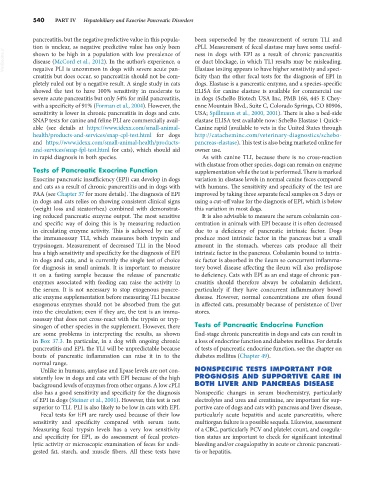Page 568 - Small Animal Internal Medicine, 6th Edition
P. 568
540 PART IV Hepatobiliary and Exocrine Pancreatic Disorders
pancreatitis, but the negative predictive value in this popula- been superseded by the measurement of serum TLI and
tion is unclear, as negative predictive value has only been cPLI. Measurement of fecal elastase may have some useful-
VetBooks.ir shown to be high in a population with low prevalence of ness in dogs with EPI as a result of chronic pancreatitis
or duct blockage, in which TLI results may be misleading.
disease (McCord et al., 2012). In the author’s experience, a
negative PLI is uncommon in dogs with severe acute pan-
ficity than the other fecal tests for the diagnosis of EPI in
creatitis but does occur, so pancreatitis should not be com- Elastase testing appears to have higher sensitivity and speci-
pletely ruled out by a negative result. A single study in cats dogs. Elastase is a pancreatic enzyme, and a species-specific
showed the test to have 100% sensitivity in moderate to ELISA for canine elastase is available for commercial use
severe acute pancreatitis but only 54% for mild pancreatitis, in dogs (ScheBo Biotech USA Inc, PMB 168, 445 E Chey-
with a specificity of 91% (Forman et al., 2004). However, the enne Mountain Blvd., Suite C, Colorado Springs, CO 80906,
sensitivity is lower in chronic pancreatitis in dogs and cats. USA; Spillmann et al., 2000, 2001). There is also a bed-side
SNAP tests for canine and feline PLI are commercially avail- elastase ELISA test available now: ScheBo Elastase 1 Quick–
able (see details at https://www.idexx.com/small-animal- Canine rapid (available to vets in the United States through
health/products-and-services/snap-cpl-test.html for dogs http://catacheminc.com/veterinary-diagnostics/schebo-
and https://www.idexx.com/small-animal-health/products- pancreas-elastase). This test is also being marketed online for
and-services/snap-fpl-test.html for cats), which should aid owner use.
in rapid diagnosis in both species. As with canine TLI, because there is no cross-reaction
with elastase from other species, dogs can remain on enzyme
Tests of Pancreatic Exocrine Function supplementation while the test is performed. There is marked
Exocrine pancreatic insufficiency (EPI) can develop in dogs variation in elastase levels in normal canine feces compared
and cats as a result of chronic pancreatitis and in dogs with with humans. The sensitivity and specificity of the test are
PAA (see Chapter 37 for more details). The diagnosis of EPI improved by taking three separate fecal samples on 3 days or
in dogs and cats relies on showing consistent clinical signs using a cut-off value for the diagnosis of EPI, which is below
(weight loss and steatorrhea) combined with demonstrat- this variation in most dogs.
ing reduced pancreatic enzyme output. The most sensitive It is also advisable to measure the serum cobalamin con-
and specific way of doing this is by measuring reduction centration in animals with EPI because it is often decreased
in circulating enzyme activity. This is achieved by use of due to a deficiency of pancreatic intrinsic factor. Dogs
the immunoassay TLI, which measures both trypsin and produce most intrinsic factor in the pancreas but a small
trypsinogen. Measurement of decreased TLI in the blood amount in the stomach, whereas cats produce all their
has a high sensitivity and specificity for the diagnosis of EPI intrinsic factor in the pancreas. Cobalamin bound to intrin-
in dogs and cats, and is currently the single test of choice sic factor is absorbed in the ileum so concurrent inflamma-
for diagnosis in small animals. It is important to measure tory bowel disease affecting the ileum will also predispose
it on a fasting sample because the release of pancreatic to deficiency. Cats with EPI as an end stage of chronic pan-
enzymes associated with feeding can raise the activity in creatitis should therefore always be cobalamin deficient,
the serum. It is not necessary to stop exogenous pancre- particularly if they have concurrent inflammatory bowel
atic enzyme supplementation before measuring TLI because disease. However, normal concentrations are often found
exogenous enzymes should not be absorbed from the gut in affected cats, presumably because of persistence of liver
into the circulation; even if they are, the test is an immu- stores.
noassay that does not cross-react with the trypsin or tryp-
sinogen of other species in the supplement. However, there Tests of Pancreatic Endocrine Function
are some problems in interpreting the results, as shown End-stage chronic pancreatitis in dogs and cats can result in
in Box 37.3. In particular, in a dog with ongoing chronic a loss of endocrine function and diabetes mellitus. For details
pancreatitis and EPI, the TLI will be unpredictable because of tests of pancreatic endocrine function, see the chapter on
bouts of pancreatic inflammation can raise it in to the diabetes mellitus (Chapter 49).
normal range.
Unlike in humans, amylase and lipase levels are not con- NONSPECIFIC TESTS IMPORTANT FOR
sistently low in dogs and cats with EPI because of the high PROGNOSIS AND SUPPORTIVE CARE IN
background levels of enzymes from other organs. A low cPLI BOTH LIVER AND PANCREAS DISEASE
also has a good sensitivity and specificity for the diagnosis Nonspecific changes in serum biochemistry, particularly
of EPI in dogs (Steiner et al., 2001). However, this test is not electrolytes and urea and creatinine, are important for sup-
superior to TLI. PLI is also likely to be low in cats with EPI. portive care of dogs and cats with pancreas and liver disease,
Fecal tests for EPI are rarely used because of their low particularly acute hepatitis and acute pancreatitis, where
sensitivity and specificity compared with serum tests. multiorgan failure is a possible sequela. Likewise, assessment
Measuring fecal trypsin levels has a very low sensitivity of a CBC, particularly PCV and platelet count, and coagula-
and specificity for EPI, as do assessment of fecal proteo- tion status are important to check for significant intestinal
lytic activity or microscopic examination of feces for undi- bleeding and/or coagulopathy in acute or chronic pancreati-
gested fat, starch, and muscle fibers. All these tests have tis or hepatitis.

